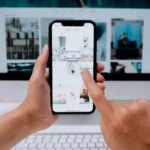When it comes to bike touring navigation, cyclists have different preferences on tracking devices that best work for them depending on experience, personality and exposure. As a beginner, you will need to settle on a mapping option that will best suite your touring escapades. This article will shed light on why most cyclers prefer Garmin GPS and why Smart Phones are taking over the GPS glory.
GPS Tracker or Smartphone?

GPS Tracker
We cannot mention GPS in bike touring without mentioning Garmin, the renowned computer GPS tracker that is widely used by cyclists in road touring ventures. It’s all-round and constantly improving features makes it a favorite to many. Some features include:
• Ideal for the performance-driven cyclist
Besides showing the distance, location and map, Garmin GPS Edge 500 and Edge 510 show the cyclist’s speed, heart rate and the amount of calories burnt. Hence, people that cycle for fitness or for racing are better placed with a Garmin out front mount.
• Connectivity
Cyclists now enjoy greater connectivity with Garmin 510 and 810. With its added Bluetooth feature, cycling with the GPS tracker and a Smart Phone has become more fun as location and cycling data can be transferred between the devices. This feature has also added interactivity to the sport since you can connect with your friends or coach live as you cycle!
• Reliability on short, quick routes and very remote areas
GPS receivers are very accurate in tracking your current and previous location and distance, and calculating the next destination. Its features include tracking back-road routes that would not otherwise be found on a map.
• Following tracks
With a Garmin GPS, you can follow a route that was uploaded by someone else who earlier took the route you intend to take due to its uploading features. This helps cyclists to take recommended routes.
Despite these advantages, Smartphones are still the main competitors against GPS devices. What are some advantages that have led many to opt for SmartPhones?
• User friendliness
Smartphones remain to be one of the most user-friendly devices for various functions, even when it comes to mapping. With its fast zooming and sliding features, Smartphones are the best in studying maps. This is however harder with a GPS device because of its menu options, which is a setback in speed.
• Charge quicker
A Smartphone can take lesser time to charge compared to a GPS tracker that takes upto 5 hours to fully charge. Although SmartPhones can keep charge for a lesser time, especially when in active use, charging solutions like power banks have made phones more effective in terms of power.
• Multipurpose device
One can make calls, Google, tour different types of maps and do further research, email.., the list goes on and on for the countless things that one can do with a SmartPhone as it still serves the purpose of offering direction. It is the ideal device when you want to ride in the lightest way.
Although both devices are reliable, it is good to note that there is no perfect mapping device. You just have to settle on one that is more practical to you because at the end of the day, what matters is that you have fun.
BIO:
Chris Clark is a passionate traveler with a passion for cycling spanning for more than a decade. Click here to see his recommendations for the best Garmin out front mounts. 🙂
Join 25,000+ smart readers—don’t miss out!







1 Comment
Best service ever! thanks for sharing Navigation guide…